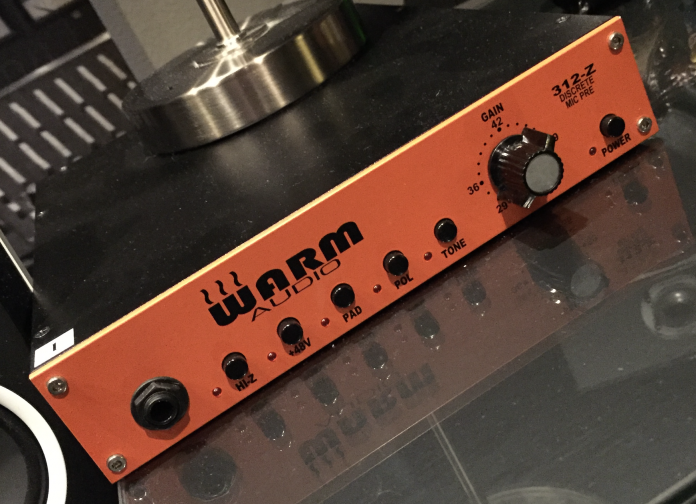Well just as I expected, my inbox has been inundated with emails calling me a shill, over-hyping a product, and “too sexy to report on pro audio.” While the last one may be true, the other two could not be more absurd so in preparation, I had raw WAV files to back up my claim. NOTE: if you really don’t believe me after this, I’ll send you to Pro Tools Session and you can see these are raw files, if that’s not enough, I don’t know what else to tell you because it’s not like he’s trying to sell you a pre for $1000. It’s half that and honestly, if you need that much proof over that little dough, you might need to find a new hobby. So here we go.
A little background on this particular session:
DAW – Pro Tools HD9
Clock Source – The new Avid HD I/O (which isn’t that great to begin with but don’t get me started)
Microphone – Blue Spark on every track (I wanted to keep it inexpensive)
Acoustic Guitar – Breedlove Atlas
Electric Guitar – Paul Reed Smith NF3
Guitar Amp – Matchless Avalon 2 channel on channel 1 (Fun Fact on that amp, there’s only 3 in the world and I have the last one made)
Guitar Effects – Pigtronix Echolution
If you’re looking for the written review of the WA-12 look no further, HERE is the link.
Also for good measure, HERE is a review of the Blue Spark for those interested in buying one to match the WA12 in color. Fun Fact 2: They actually use the exact same color to make each of them.
Ok now that we got that out of the way and everyone knows every aspect of the gear, lets get down to brass tax.
Here we have the acoustic guitar ran through the SSL VHD. I added a little bit of the Variable Harmonic Drive to give it as vintage of a sound as I could
NOTE: I tried to meter these things as close as I could as not to bias any pre’s with the louder is better theory, but seeing as I had no metering on any of the pre’s, I had to use T-Racks metering program to get it as close as I can.
AGT SSL VHD by Everything Recorded
Sounds pretty good right. Well let’s run it up against the WA12 to see how well it holds up.
AGT WA12 Tone in by Everything Recorded
I did engage the tone button on the WA12 to add that little oomph to the track. I do hear less bite in the WA12 than the SSL as well as more pronounced tone in the high mids. So if we’re getting a more full-bodied sound out of the WA12, lets see how it works against the Millennia, which is known for extremely transparent open sound.
AGT Millennia by Everything Recorded
I don’t want to sound biased but the Millennia sounds flatter than the WA12… just saying.
Onto Electric Guitar.
Once again, the SSL VHD
EGT SSL VHD by Everything Recorded
That’s a pretty good benchmark for a decent dry electric guitar track. SSL always has the punch and with the Variable Harmonic Drive, adds just a little of the vintage to it. And now the WA12
EGT WA12 by Everything Recorded
I’d say they sound fairly identical on electric. That’s a huge feather in Warm Audio’s cap due to SSL being a go-to for most engineers on rock tracks. Now for fun lets throw the Millennia in the mix again.
EGT Millennia by Everything Recorded
I can hear just a slight boost in the 8-10Khz in the Millennia but it’s just barely noticeable. All in all I say they all sounded very close on that comparison. Keep in mind, this pre is $449.00.
Now lets try some female vocals.
Here is the SSL VHD
FVOC SSL VHD by Everything Recorded
Great sounding as usual. And now with the WA12
FVOC WA12 Tone in by Everything Recorded
I did engage the tone button again on the female vocal to add more low end and it seemed to add quite a bit more than the SSL did while still retaining the highs. So now lets throw it in the ring with the Millennia.
FVOC Millennia by Everything Recorded
Definitely lacking the same low end either of the pre’s have, it still retains the highs and sparkle Millennia is known for. So lets take the tone button off and see if we can replicate Millennia’s sound with the WA12
FVOC WA12 by Everything Recorded
Not too shabby…
Now just for fun, Here is 3 acoustic tracks and the female vocal all recorded together STILL with no processing of any kind. This is straight off of the pre into the DAW on each track. All I did was pan the two rhythm tracks and flip the polarity with the preamp on the one on the right side.
All WA12 Song by Everything Recorded
As always, Everything Recording encourages everyone to their own opinions, so feel free to argue my points. Just don’t get too heated… No one’s looking for a fight, unless it’s an exact recreation of the fight scene in Anchorman.








